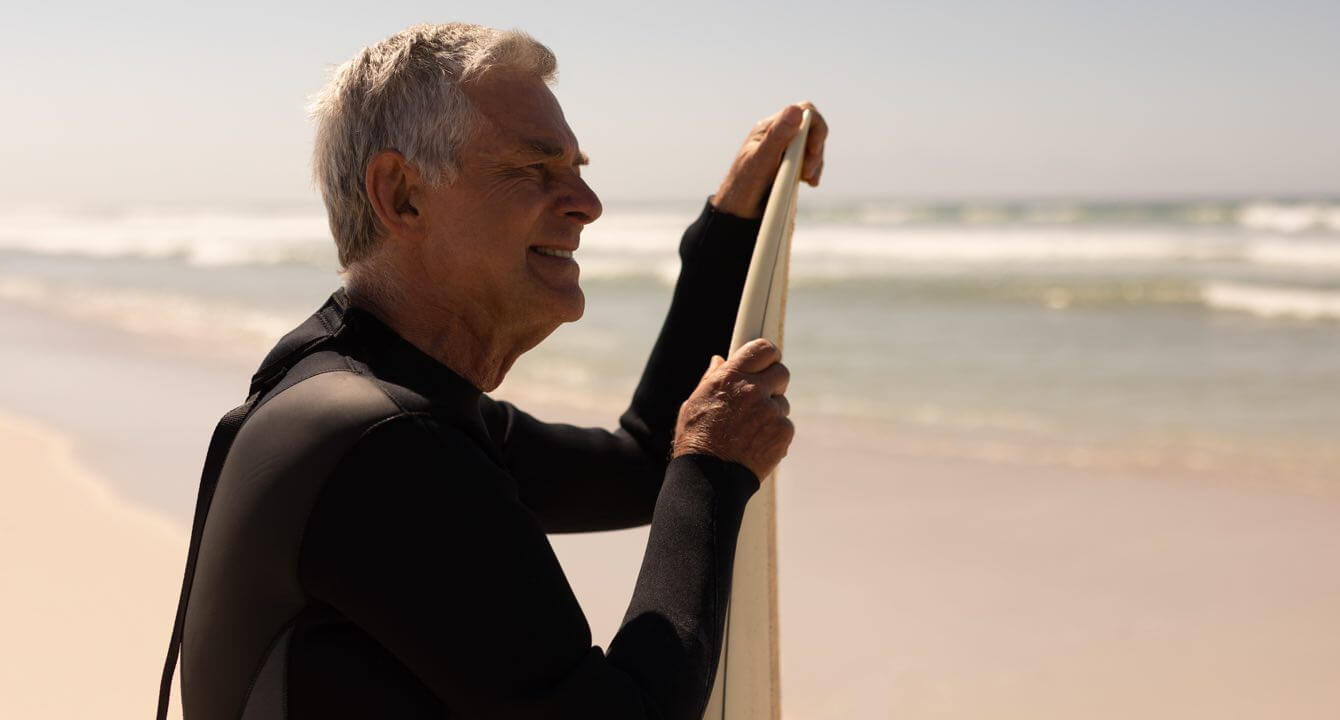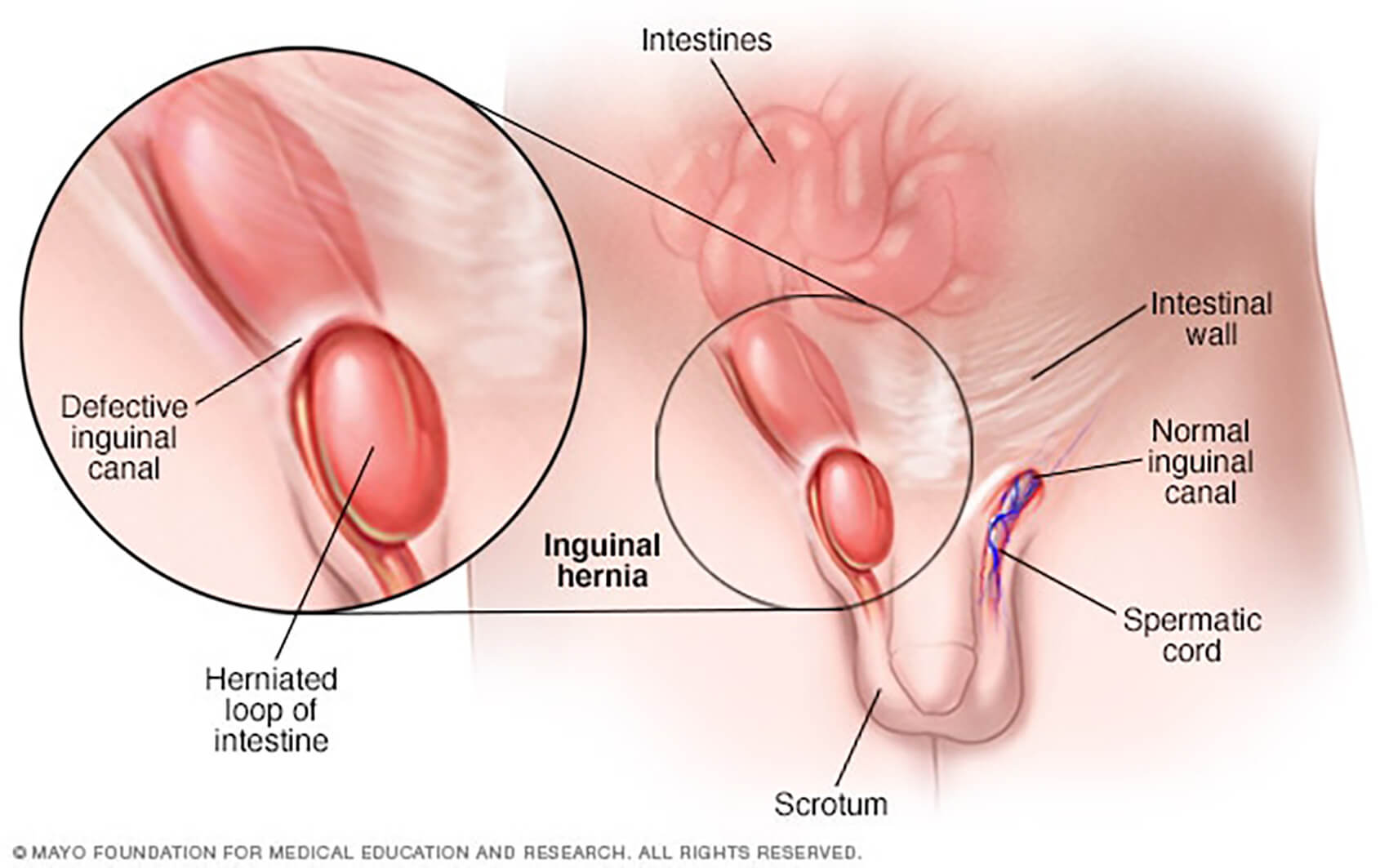Inguinal hernia Perth
Pete is back on his board after inguinal hernia surgery.

Inguinal
hernia
An Inguinal hernia, also known as a groin hernia, can often go undetected when it occurs on men or women. However, if they grow to a larger size, they can be very painful and require treatment.
Surgery is the best approach for resolving inguinal hernias and preventing a recurrence.
What is a groin hernia?
A hernia occurs when there is a defect or an area of weakness in the layer of muscle that forms the abdominal wall. Part of the soft tissue of the abdominal cavity pushes through the wall, resulting in a lump that you can feel. This trapped lump is a hernia.
A groin hernia is also known as an inguinal hernia because it occurs at the site of the inguinal canal. In men, the inguinal canal is a narrow passage in which the blood vessels found at the root of the testicles (that supply blood to and from the testicles), pass through the abdominal wall. In women, the inguinal canal, and therefore the inguinal hernia, occurs in relation to the round ligament of the uterus.

A direct inguinal hernia occurs medial to the inferior epigastric vessels, whereas an indirect inguinal hernia occurs lateral to the inferior epigastric vessels. This description is really for research purposes only, as the treatment for both types is essentially the same.
One in four men will get an inguinal hernia in their lifetime.
Femoral hernias also occur in the groin, in an area of natural abdominal wall weakness known as the femoral canal. This region is a little closer to the inner thigh. Although less common, they tend to be tighter and have a tendency to become more easily strangulated, leading to serious medical issues.
What symptoms could I expect with groin hernia?
Are inguinal hernias painful?
A bulge or lump either side of your pelvic bone. This may become more obvious when you are sitting up rather than lying down, or if you cough or strain your stomach muscles.
Pain or a burning sensation in the area of the lump, especially when bending, coughing, or lifting something.
A sensation that the lump pops in and out of the area.
A heavy or dragging sensation in your groin.
Weakness or pressure in your groin.
In men, there may be an occasional pain or swelling around the testicles when the protruding intestine descends into the scrotum.
Is inguinal hernia surgery painful?
Not really. Any operation will be uncomfortable, but the secret is to stay on top of the pain with medication. We use a combination of neuromodulators, local anaesthetic infusions, and good old fashioned pain-killers, to minimise and manage perioperative pain.
During their inguinal hernia recovery, most of our clients comment that the surgery was a lot less painful than expected. They find they are able to return to work (depending on the type of work that they do) 2-3 weeks after surgery.
We recommend regular gentle exercise after surgery as a beneficial way of helping to return to normal activities as soon as possible.
How are inguinal hernias repaired?
Laparoscopic inguinal repair
Laparoscopic inguinal repair involves a repair using a keyhole approach. We find that patients often recover better with a laparoscopic approach, with less pain and less long term issues.Open inguinal hernia repair
Open inguinal hernia repair has been around for almost 140 years, but has become very refined in the past 40 years, particularly with the inclusion of mesh products to support the repair. The recovery from an open repair is still quite quick, but not as good as that seen with a laparoscopic repair.Non-mesh hernia repair
Non-mesh hernia repair procedures do exist for inguinal hernia treatment, but their long term results are not as good as mesh repairs. There are also more long-term issues with chronic pain. There are many claims for magical hernia repairs that are advertised on the web, but none have ever been investigated closely for their long-term effectiveness.Do inguinal hernias always require surgery?
Yes; the benefits of a surgical approach to hernia repair is that following surgery you no longer have the hernia.
There are padded support belts that are available to control your hernia using a truss. However, it is important to be aware that your hernia will not get better without surgery.
The nature of hernia is that your hernia will just get bigger with time. It’s better to deal with the hernia sooner rather than later before they get too large. Larger hernias are harder to repair, the recovery is longer, and the risk of the repair failing is greater.
Surgery should prevent the serious complications that a hernia can cause. So the rule for hernias is: the sooner the better.
About Obesity Surgery WA: Our 6 commitments
Taking surgery seriously
We know that entering into an operation is a big deal and we are very serious in getting the best outcome for you. We practice what is considered to be a world class standard. Our staff regularly attend national and international conferences and bring back what is the latest research and technology.Running on time
Our Surgeons and all of our staff try their best to run on time. Although it's not always possible, our commitment is that we do our best. Your time is valuable and we respect that.Readily available
Our surgeons (or at least one of them) are always available in a crisis. Some of them may provide you with a direct contact, but all are available through the hospital switchboard and happy to chat any time if there is a crisis.An obsessive attention to detail
We do our best to not miss anything. Every stitch, every staple and every clip is applied to exactly where it needs to be with the greatest care possible.Commitment to performing the best operation possible
Not all operations are the same and there a few extras that we do to make things better. We know that our results are better with the minimiser ring so we offer it to everyone. We know that reflux can be an issue so we try to tighten every oesophageal hiatus to make reflux control as good as possibly can be.A commitment to new technologies
- We have brought in STRETTA into Western Australia, which we believe will revolutionise reflux management. (Have a look at the Stretta page for more information).
- SJOG Murdoch has just purchased a new DaVinci robot and we believe that this will allow us to do operations with keyhole surgery that previously needed a major laparotomy incision. Lynx is on the horizon and promises to also help manage reflux, we hope to have access to this in early 2020.
Useful links
Patient
information
Our team of surgeons, bariatric physicians, dietitians and nurses, along with our wonderful support staff.
About
Obesity Surgery WA is lead by Dr Harsha Chandraratna. After graduating at UWA, Harsha began his surgical training and was made a Fellow of the Royal Australasian College of Surgeons in 2001. Dr Chandraratna understands the impact of obesity. He personally had sleeve gastrectomy surgery, which gives him a really deep level of understanding when he works with his patients on a daily basis.
Meet our team

Dr. Harsha Chandraratna
Consultant Surgeon
MBBS FRACS

Dr. Bill Gong
General and Laparoscopic Surgeon
MBBS FRACS
